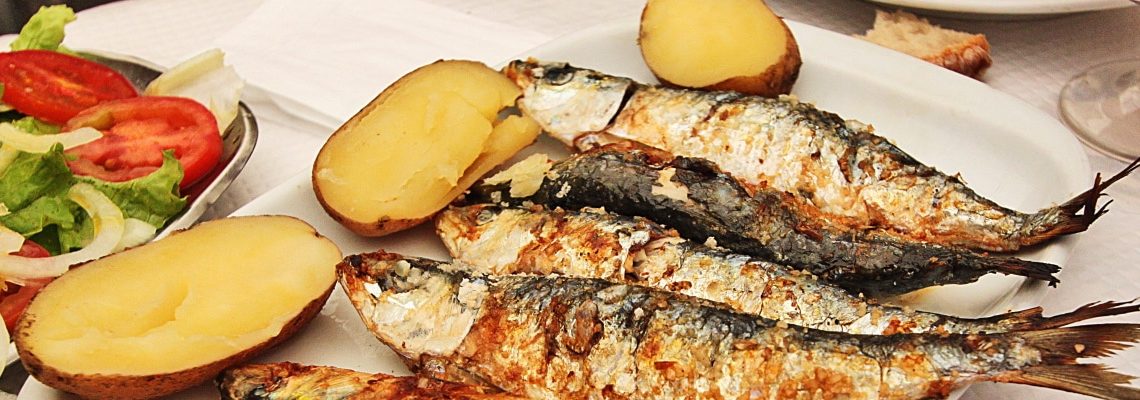The sardine, as a symbol of Portugal, has become so ubiquitous that it’s hard to miss, even before you step foot in a restaurant. You’ll see its outline in every souvenir shop – painted metal cutouts, magnets, T-shirts, mugs – and the Sardinha by Bordallo Pinheiro collection from the famous Portuguese ceramics company has taken it to a whole new artistic level. When it comes to actually eating, fresh, grilled sardines may come as a surprise to those who have only experienced the canned version, but it is such a beloved part of Portuguese cuisine and tradition that it has morphed into an iconic cultural image.
Lore says that sardines should only be eaten in months that don’t end in “-ro” (in Portuguese), which means March-August. The season really gets going in May, though, and hits full stride as traditional festivities begin in June – Portugal Day on June 10th, followed by the Santos Populares (Popular Saints) festivities that are local holidays throughout the country – Saint Anthony (June 12-13), Saint John (June 23-24) and St. Peter (June 29). The Portuguese live for summer, so these holidays that herald the season of fresh air and sunshine just give an extra excuse to head outside and party. Which saint’s day is celebrated varies by municipality, but they are marked by colorful street celebrations, and (depending on the saint) the offering of fragrant pots of sweet basil bedecked with little love poems or bonfire jumping. And, everywhere, the smell of sardines roasting on outdoor grills.
Whole sardines will usually be served with boiled potatoes, a green salad, and perhaps grilled red and green peppers. Whether to eat or peel off the skin is an individual choice, but definitely leave the innards; sardines aren’t gutted for cooking! And you’ll have to master the art of sliding the flesh off the delicate bones. If the environment isn’t too fancy, you can pick them up and eat with your hands. Whatever you do, do not skip mopping up the juices with good, hearty Portuguese bread; that’s what it’s there for. Fresh sardines are smallish – not as small as the tinned version, but most people will be able to eat two or three at a sitting. At a sardinhada (a dedicated sardine dinner) with some real fans, though, the pile of skeletons can get downright embarrassing.
Washed down with light, slightly fizzy vinho verde (green wine) or a crispy, chilly white, this is Portugal on a plate.
Sardines aren’t the only fish game in town, of course. Salt cod (bacalhau) is another fish famously associated with Portugal that is used in literally hundreds of dishes; in its fresh form it will specifically be referred to as bacalhau fresco. Many other varieties of fresh fish are widely available; part of the ritual of going to a Portuguese restaurant is checking out the catch of the day on its icy bed. Some household favorites to look out for: Robalo (sea bass), Dourada (gilthead sea bream), Cherne (stone bass), Linguado (sole), Garoupa (dusky grouper) and Peixe-galo (John Dory). Take note: peixe-espada translates directly as swordfish, but it is actually scabbard fish, an entirely different creature. The fish known as swordfish in English is espadarte in Portuguese.
Fresh fish in Portugal will typically be grilled to simple perfection, with just a sprinkle of sea salt to set it off, drizzled with olive oil (sometimes heated with garlic) and a spritz of lemon. But another delicious way it can be prepared is baked whole in bread dough or in sea salt. The fish being brought to the table in a flaming coat of salt is a sight to behold. It is then chiseled open, and inside it will be juicy and perfect, not salty at all. In that case, the Portuguese waiter will take it off the bone for you, and that is like watching an artist at work.
For a taste of Portuguese cuisine, come on a Terracotta Journeys tours.
By Holly Blades

